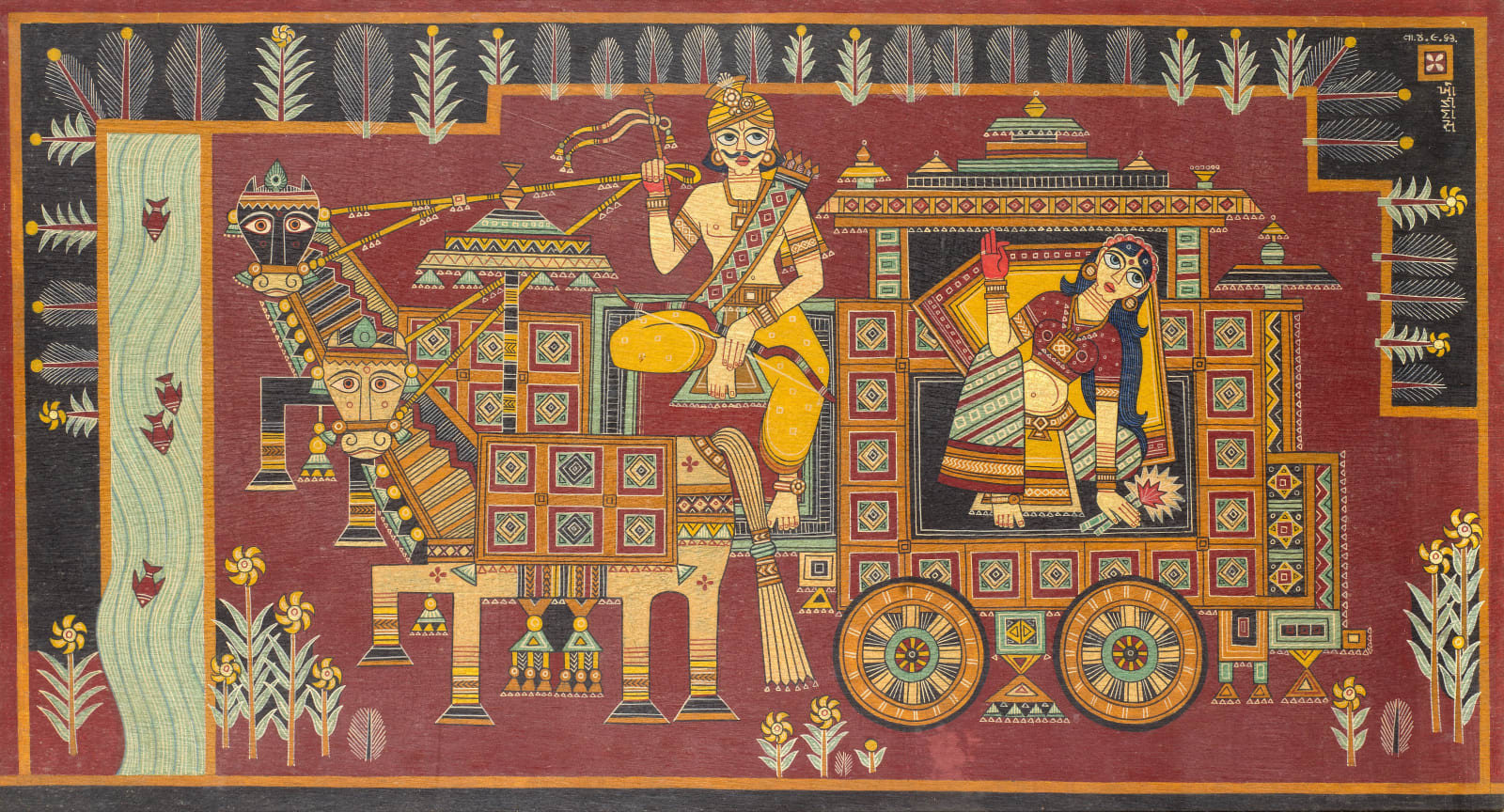Khodidas Parmar
Untitled (Arjuna riding a chariot), 1953
Oil on board
43.3 x 79.8 cm
17 x 31 3/8 in
17 x 31 3/8 in
Signed and dated '4.6.53' upper right
Parmar was a distinguished artist celebrated for his contributions to the folk-art traditions of Gujarat. Deeply rooted in the cultural heritage of his region, Parmar's works vividly reflected the rural...
Parmar was a distinguished artist celebrated for his contributions to the folk-art traditions of Gujarat. Deeply rooted in the cultural heritage of his region, Parmar's works vividly reflected the rural life, customs, and mythologies of Gujarat, often rendered in a bold and colourful folk style. The current lot is fantastic example of this. Depicting a rider and woman in a chariot drawn by two horses, the painting embodies the essential aesthetics and storytelling sensibilities of this enduring genre. Set against a vivid red background, the composition is meticulously detailed, each element rendered with an almost obsessive precision that is typical of the finest folk paintings and scrolls.
The two horses, which face the viewer head on, exude both dynamism and symmetry. Their gaze, fixed and wide-eyed, creates a visual confrontation that is immediately compelling. Next to them, the woman sits in the chariot in stoic composure, flanked by the driver. The figures are rendered in the flattened, stylized tradition, similar to patachitra - elongated eyes, curved limbs, and ornate costumes, all of which blur the lines between human and doll-like forms.
What elevates this piece beyond simple folk representation is the elegant border of foliage that crowns the top and drapes the sides of the painting. This leafy frame not only enhances the visual rhythm but also anchors the scene in the natural world, a reminder of the close relationship between human life and the environment in village life and mythologies. Each leaf and vine appears hand-drawn with care, demonstrating the artist's skill and dedication to detail.
Symbolically, chariot scenes in Indian folk art often represent divine or heroic journeys, possibly referencing episodes from the Ramayana, Mahabharata, or local folk deities. Here, however, the anonymity of the figures and the stylization suggest a broader metaphor; a timeless journey through life, fate, or devotion. The bold red background serves as an emotional and visual anchor, a colour often associated with auspiciousness, energy, and divine presence in folk culture.
This work not only exemplifies the vitality of Gujrat's folk art traditions but also underscores their sophistication and symbolic depth. The artist's ability to combine formal naivety with narrative complexity creates a piece that is at once decorative, spiritual, and contemplative. In today's art world, where boundaries between traditional and contemporary are increasingly fluid, such a work offers a valuable lens into a living artistic heritage that continues to inspire both collectors and contemporary artists alike
The two horses, which face the viewer head on, exude both dynamism and symmetry. Their gaze, fixed and wide-eyed, creates a visual confrontation that is immediately compelling. Next to them, the woman sits in the chariot in stoic composure, flanked by the driver. The figures are rendered in the flattened, stylized tradition, similar to patachitra - elongated eyes, curved limbs, and ornate costumes, all of which blur the lines between human and doll-like forms.
What elevates this piece beyond simple folk representation is the elegant border of foliage that crowns the top and drapes the sides of the painting. This leafy frame not only enhances the visual rhythm but also anchors the scene in the natural world, a reminder of the close relationship between human life and the environment in village life and mythologies. Each leaf and vine appears hand-drawn with care, demonstrating the artist's skill and dedication to detail.
Symbolically, chariot scenes in Indian folk art often represent divine or heroic journeys, possibly referencing episodes from the Ramayana, Mahabharata, or local folk deities. Here, however, the anonymity of the figures and the stylization suggest a broader metaphor; a timeless journey through life, fate, or devotion. The bold red background serves as an emotional and visual anchor, a colour often associated with auspiciousness, energy, and divine presence in folk culture.
This work not only exemplifies the vitality of Gujrat's folk art traditions but also underscores their sophistication and symbolic depth. The artist's ability to combine formal naivety with narrative complexity creates a piece that is at once decorative, spiritual, and contemplative. In today's art world, where boundaries between traditional and contemporary are increasingly fluid, such a work offers a valuable lens into a living artistic heritage that continues to inspire both collectors and contemporary artists alike
